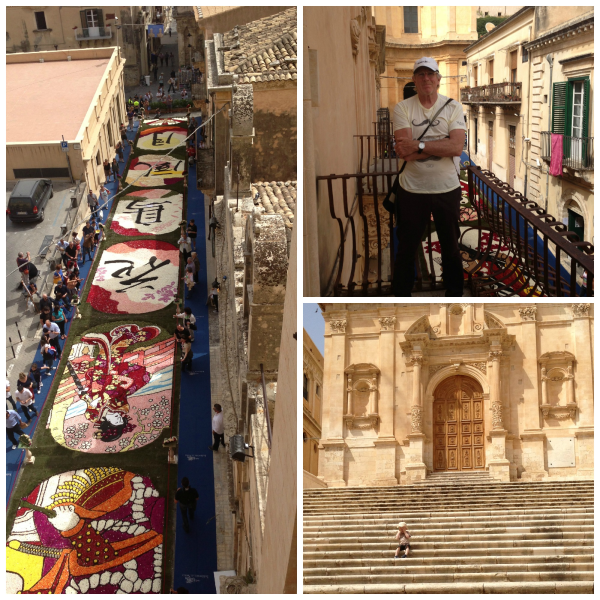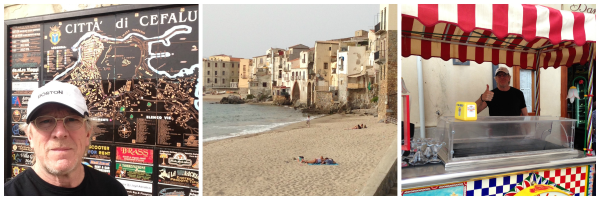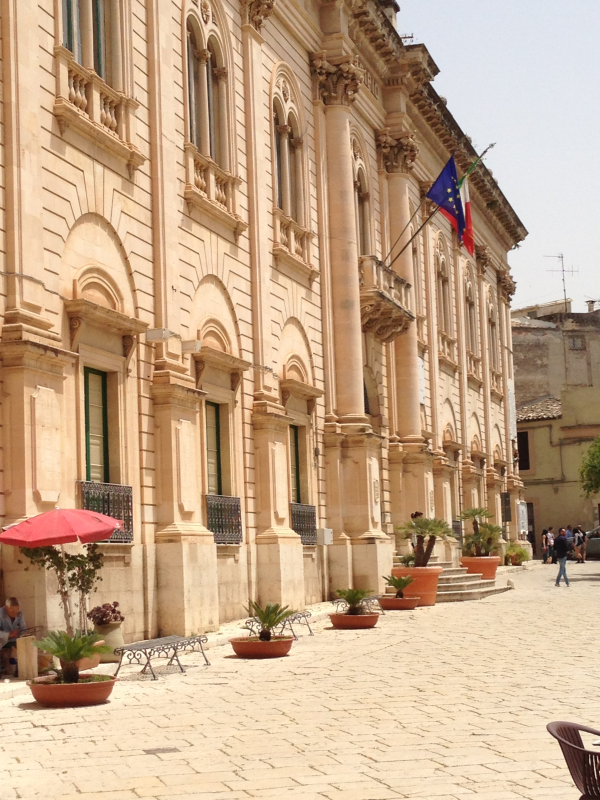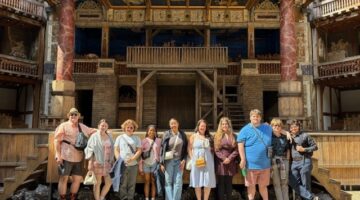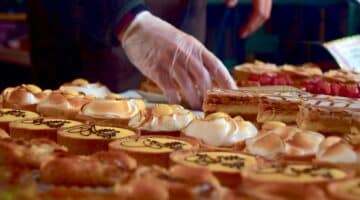My Return to Sicily, Part 2

Today we headed to the town of Noto, one of the eight towns in South-Eastern Sicily that were rebuilt after 1693 due to a huge earthquake. All of the architecture was built using the local limestone. These eight towns represent what is considered to be late-Baroque style. This was a defiant answer to the wrath of nature (the earthquake) and an ambitious affirmation of wealth and the religious order delivered by the local aristocracy. The limestone—all honey-colored or pale white—is like no Baroque you have ever seen.
Noto is only 31 miles from Ragusa and the cathedral and the town’s central district have been beautifully restored. In fact, the eight towns that make up this cluster are all gems in their own right. The approaches to these towns remind me of the barren landscapes in Rajasthan, India; green fertile plains, dramatic rock faces, with clusters of houses literally looking like they have been carved into this mountain of rock, and always a church or a cathedral at the top.
When we arrived in Noto we were fortunate because the annual Flower Festival which takes place every May was happening. This year the festival was based around Japanese-influences and the street leading up to Town Hall was decorated in flowers that portray Japanese paintings and writings. There were balloon sellers lining the streets and the whole town had a magical party atmosphere. Noto incidentally has the best gelato in all of Italy. There is nothing better in the world then taking in the sites while tasting the delights of a lemon and pistachio gelato. Especially when you can see the lemon and pistachio trees about a hundred yards away.
Eventually we headed into Modica, another Baroque town, for an evening stroll and dinner. Modica is a place that you can imagine living. It has beautiful architecture, the best chocolate store in the world called “Antica Dolceria Bonajuto,” and the steepest steps that I have ever climbed. Exhausted, we settled into another spectacular Sicilian meal and headed back to Ragusa for the last night.
The Journey to Mount Etna
We stopped in the early morning at the delightful town of Scicli; again, another spectacular Baroque feast. It was described by the art historian Anthony Blunt as “Baroque preserved in aspic.” We visited a couple of churches including the great church of St. Ignazio and caught a glimpse of the extraordinary Madonna of the Militia. She is said to have saved the local Normans from an attack by invading Moors in 1091. The power of women.
The sun was high and the colors of the limestone made the town a breathtaking site. But we had to push on heading through Siracusa and visiting another Baroque fantasy in Ortygia before moving on and connecting with the main autostrada that took us through Catania and on to Etna. The day was warm and sunny and at the top it appeared that Mount Etna looked clear.
The drive up to Etna is a drive of gradual transition and you have no idea what you are getting into. The green of the lowest slopes gradually gives way to black volcanic rock. The road then starts turning and turning as you make your way up this mammoth mountain. As you get higher, the temperature descends rapidly. At 13,000 feet, Etna is a giant, one of the grandest volcanos in the world.
At the mid-station, we jumped out of our car and got into a cable car for the ride up the mountain to connect with a 4-wheel drive vehicle. The weather had now changed. A cloud had come in, the wind had picked up, the temperature had dropped, and all of us felt hopelessly underdressed. The journey on the 4-wheel drive trucks took us through banks of ash covered snow that were 20 feet high. Once to the top, we were delivered to winds that nearly blew us over. We walked with a guide along a narrow volcanic path of black lava to the mouth of one of the openings of the volcano. It was so cold and so windy and so high, that I wondered if we would ever make it back.
But thank goodness we did.
Once we reached the balmy and beautiful Taormina, Etna seemed a mountain away. Dinner in Aci Trezza and another spectacular meal to close out the day.
Final Thoughts on Sicily
I am pleased that I returned to Sicily because I really got it wrong the first time.
I loved Palermo. It is a great and fascinating city, rich in history, filled with markets and activity, fabulous food, and the best beaches of any European city.
The Baroque towns of Ragusa, Noto, Modica, and Scicli were a revelation to me. They are also great places to stay and base yourself for excursions to the other Baroque hill towns nearby. The northwest part of the island and Segesta specifically were well worth the visit and are an easy day’s outing from Palermo.
We also visited Cefalù to the east of Palermo and this can be done as a simple excursion in an afternoon. It has a beautiful cathedral and a lovely old town with beaches and umbrellas that sit in the backs of the houses and shops that curl around the center. In May people were already swimming although the locals were decidedly not.
Sicily is drivable and manageable and Palermo or Ragusa can be wonderful and convenient hubs to visit other places. Of course, nothing is more charming than ending in Taormina with its Greek temple and the imposing Etna nearby.
As for Siracusa, it is a good stop between Ragusa and Taormina especially when going to the island of Ortygia. As for Agrigento and Piazza Armerina, they are places worth visiting if you have the time, but they can be avoided at no great cost to the pleasure and love of this beautiful island.
There are so many amazing things to do and see and so much history packed into this tiny piece of land—the football at the edge of the boot—that there is no question of an imminent return.
The gelato alone would make it worthwhile.
